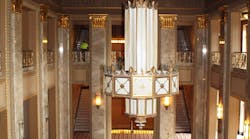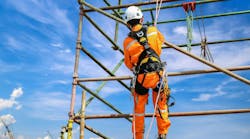Kaiser Electric was recently honored with a Regional Excellence Award from St. Louis Construction News and Review (CNR) for its work on the Peabody Opera House historic renovation project. The CNR Regional Excellence Awards were established in 1989 to recognize projects that demonstrate excellence in design and construction and make a positive contribution to the St. Louis community. The awards are presented to the owner, designer, and contractor/construction manager. Nominations were judged by a jury of educators and industry executives.
Kaiser Electric began renovating the electrical and lighting systems in the 76-year-old, art deco jewel at 14th and Market Streets in Downtown St. Louis in June 2010. Plans for the Peabody Opera House, formerly named the Kiel Opera House, included renovation of its main theater, which seats 3,200 people, and its smaller theaters with seating for 300 to 500 people. The $6.5 million electrical component of the building’s total $78.7 million renovation included the design/build of a new electrical distribution system and installation of the theatrical, architectural and general lighting. The theatrical lighting system alone was estimated at $1.3 million. During peak construction, Kaiser Electric had up to 31 electricians working on the project, which was completed within budget and on schedule in August 2011.
Kaiser’s crews worked hard to maintain the historical look and feel of the building in terms of lighting, but making it more energy efficient. The building’s original 10-foot-tall, 3-foot-around lighting fixtures had to be sent out to be re-wired, plus several missing original wall sconces had to be re-created and re-wired, as well.
A challenge on the project was getting all of the historic light fixtures successfully wired into the new dimming control system. Kaiser Electric installed occupancy sensors on all lighting in the building’s “back of house” areas and used energy efficient fluorescent lighting where possible. Incandescent lighting was used where dimming was necessary. Kaiser’s crews also installed a backup generator outside the building for egress lighting and the elevators, a new fire alarm system throughout the building, and electrical and lighting for a new lounge and several concession stands throughout the building. Kaiser also assisted in the design and installation of LED color-shifting light fixtures in the main theater’s large center dome.
The Peabody Opera House is owned by Opera House Redevelopment Co., LLC. Martinez & Johnson were the architects on the project and Paric Corporation and KAI Design & Build were the general contractors.
The original Kiel Opera House, which was owned and operated by the City of St. Louis, was completed in 1934. The opera house was home to the St. Louis Symphony Orchestra for several years and the setting for many ballet, opera and concert performances. It was closed in 1991.



